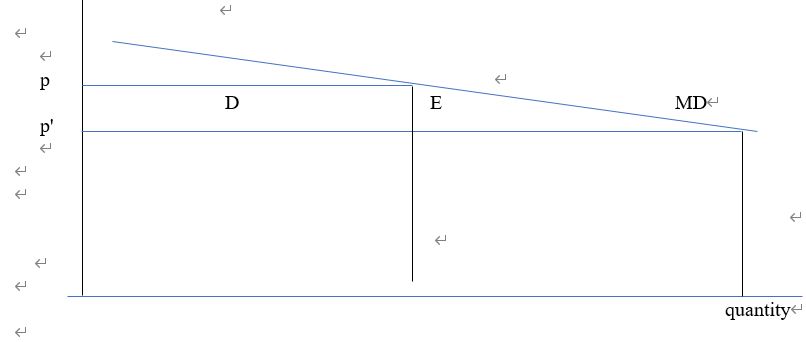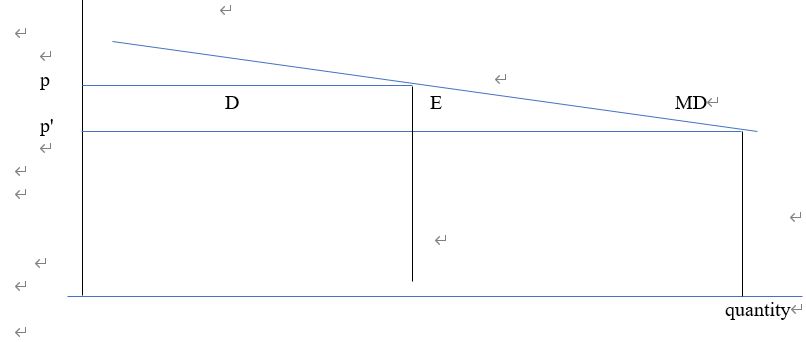Question
Prices and wages Let's see if we can figure out what effect lower wages would have on prices, and the possible welfare gains from those

Prices and wages
Let's see if we can figure out what effect lower wages would have on prices, and the possible welfare gains from those lower prices. Remember, the reason we import manufactured goods probably has more to do with the wages in countries like China, India, Indonesia, Mexico, etc. than anything else.Arguing that there is comparative advantage is, in my opinion, a very long stretch.So, how big an effect do lower wages have on prices?
Let's organize our thinking as follows. First, what will the price of a good be?What determines that?Well, as you should know, if there are constant returns to scale and free entry,
price = average cost
Average cost is the cost of the inputs used + normal profit divided by the quantity of the good produced. (Remember, normal profit is profit when the firm's rate of return in the going rate of return, the ROR that anyone with money to invest can get.)
For example.Suppose 2 million tons of steel are produced. Suppose the workers are paid $100 million (including fringe benefits, etc.), all the other inputs cost $120 million, and the firms producing the steel make a profit of $30 million on that steel.Then the cost of producing that 2 million tons of steel is $100 + $120 + $30 = $250 million.Therefore, the average cost of a ton of steel is $250 million divided by 2 million tons = $125.And that would end up being the price of steel, in equilibrium.
So, if firms pay workers less (lower wages), then one component of cost goes down and that lowers average cost and in turn price.By how much, percentage-wise?Let's figure that out.We're going to make a very strong assumption and so what we end up with is what we would call a benchmark.(Think of a benchmark as a starting point for discussion.)That assumption is an assumption about the technology being used.We'll assume there are fixed proportions.That means the quantity of a good produced divided by the quantity of one of the inputs used to produce it will always be the same.That ratio doesn't change as output changes or as input prices change.
For example, suppose a good is produced using X pounds of a raw material and a machine that is operated by two workers.If the machine is run for 8 hours, 1000 units are produced.No more, no less.What happens to production if you add a worker, ceteris paribus?Answer: nothing.(In fact, maybe it goes down, since the worker with nothing to do distracts the two individuals actually working.)What happens if we add a machine, ceteris paribus?Answer: again, nothing; there's no one to operate it.Let's look at the ratio: output over pounds of raw material used to produce that output.What is that ratio?Answer: X.It doesn't matter how much is produced, or what the price of the raw material is.The existing technology converts X pounds of raw material into 1 unit of product using 2 workers and a machine.End of discussion.
All right.Let's suppose that we have two workers and one machine. And from those inputs, we get 1000 units. (We'll forget about raw materials, to keep it simple.) Then if 2Q units are produced, 4 workers and 2 machines will be employed etc.That means that average cost is
(wage x 2 workers + price of a machine x 1 + profit)/1000
if 1000 units are produced, and
(wage x 4 workers + price of a machine x 2 + 2 x profit)/2000
when 2000 units are produced.Convince yourself that the 2 average costs are the same.(Look at the one right above and cancel out a 2 from both the denominator and numerator, i.e. bottom and top.)
Now let's go back to our steel example.
production =2 million tons of steel
labor cost =$100 million
all the other input costs = $120 million
profit = $30 million
total cost = $250 million
average cost = price = total cost/quantity produced = $250 million/2 million = $125 a ton
Note that labor cost is 40% of total cost: $100 million/$250 million = .4, or 40%. That's what we would refer to as labor's cost share.OK, what if there are lower wages in the steel industry, for whatever reason?Say wages go down by 50%.That means they are .5 x what they were.
Well, that has no effect on other input costs and profit.It just lowers that $100 million labor cost to $50 million.Remember, steel makers can't change how much labor they use to produce 2 million tons of steel.So, what does this change do to average cost and in turn, price?
Let's see.Now we have
production =2 million tons of steel
labor cost =$50 million
all the other input costs = $120 million
profit = $30 million
total cost = $200 million
average cost = price = $200 million/2 million = $100 a ton
What do we see here?Answer: a 50% decrease in wages only lowers the price of steel by $25/$125 x 100% = .2 x 100% = 20%.Why is that?Because labor cost is only part of the cost. If there were only labor costs, then a 50% decrease in labor cost would translate into a 50% decrease in average cost and thus, a 50% decrease in price.Here's the moral to this figuring: the effect of a change in wages on price depends on what part of total cost labor cost is.
Now you do the figuring. Using the amounts below, figure total cost = 1) on your answer average cost = price = 2) on your answer ; labor cost/total cost = 3) on your answer
production =2 million tons of steel
labor cost =$70 million
all the other input costs = $180 million
profit = $30 million
All right, now suppose wages are cut by 50%, what will the percentage decrease in price be now that labor's cost share is less?Put that percentage in 4) on your answer.
OK, let's think about how lower wages affect price, more generally.As it turns out, we can use the following formula:
% change in price = labor's share of costs x % change in wage
Thus, if you find that labor's share is .2 and wages go down by 60%, price will go down by .2 x 60% = 12%.
Your next question is: what is labor's share of total manufacturing costs?
1) Get on the internet and go to the U.S. Census, i.e. to www.census.gov
2) Put your cursor on "Browse by Topic"
3) Click on "Business and Economy"
4) Click on "view all tables"
5) Click on "2018"
4) Under Tables, click on the table "2018 Annual Survey of Manufactures: Tables"
Get these data:employment, payroll, and sales (the heading is actually sales, value of shipments or revenues).These data are in the first line of the table.Put those numbers in 5), 6), and 7) on the answer. Be sure to write down the actual amounts.Don't put 2,450 if the actual number is 2,450,000.
Be aware that payroll is only part of the cost of labor.It doesn't include fringe benefits (and other expenses incurred in employing a worker, such as payroll taxes).There are other files where you can get an idea as to what those are, but nice guy that I am, I'm going to tell you what fringe benefits are, ballpark.Figure they are, roughly, 30% of payroll.That is, the cost of the labor used in the U.S. manufacturing section = payroll + 30% of payroll.Calculate that using the number you got for payroll, and put that number in 8) on the answer.
Recall that
revenues = the cost of labor + the cost of all other inputs + profit = total cost
Using 8) and sales (the datum you got from the Census), figure what % of total cost labor cost is and put that in 9) on the answer. Not such a large percent, huh?
Well, how much lower are wages in China and India and other places where goods are manufactured and then exported to the U.S.?I'm not going to have you get data on that.I've seen estimates by country, and these indicate that unit labor cost in China, India, and Mexico could be as low as 10% of what it is in U.S. manufacturing.So let's say that wages and fringes are 10% of what they are in the U.S. That means they are what percent less?Answer: 90%
Now let's figure how much less prices would (possibly) be when goods are manufactured in low wage countries instead of the U.S.How? Use the formula I gave you above relating the percentage change in wage, labor's cost share, and the percentage change price to figure that. Put that % in 10).
What do you think?But the question is, what is the welfare gain from that decrease?Let's figure that out.
Look at the graph below.The increase in consumers' surplus when prices go down is the benefit to consumers from those price decreases in dollars. (So what does consumers' surplus measure?What does it mean to say it's the benefit from lower prices?Answer: it is ___ for lower prices.Put what should go in the blank in 11)).
As you can see, there are two parts to it, right?The area of a rectangle (area D) and the area of a triangle (E).You can figure the area of the rectangle using the numbers you calculated.Why?That area is just the decrease in spending on what was being bought originally.So if spending on a group of goods was originally $3 billion, and the prices of those goods when down by say 10%, how much less would be spent on that group of goods if they were purchased at the lower prices?Answer: 10% of what was originally spent! That is $300 million.
What we want to know is the welfare gain from the lower prices of the goods we're currently importing.That's one component of the benefit from current trade policy, and therefore, what we would lose if we drastically cut imports.Also, we're going to confine our attention to consumer goods imported from Asia and Mexico (Asia excluding Australia and Japan), i.e. countries were wages are considerably lower than they are here in the U.S.

Step by Step Solution
There are 3 Steps involved in it
Step: 1

Get Instant Access to Expert-Tailored Solutions
See step-by-step solutions with expert insights and AI powered tools for academic success
Step: 2

Step: 3

Ace Your Homework with AI
Get the answers you need in no time with our AI-driven, step-by-step assistance
Get Started


